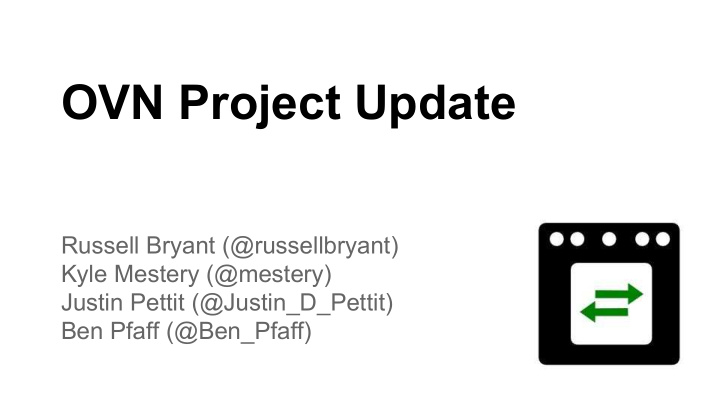



OVN Project Update Russell Bryant (@russellbryant) Kyle Mestery (@mestery) Justin Pettit (@Justin_D_Pettit) Ben Pfaff (@Ben_Pfaff)
The Case for Network Virtualization • Network provisioning needs to be self-service. • Virtual network needs to be abstracted from physical. • Virtual network needs same features as physical. A B D E HV1 HV2 S S A B C F C R S D E H G S S F G H Cloud Physical Network Legacy Physical Network
Why Start OVN? • Virtual networking for OVS, done from scratch using experience built up in the OVS project • Natural evolution of the project--OVS had only provided the components to build a distributed switch • Cloud management systems agnostic
Why Should OpenStack Care? • Neutron’s primary job is to provide a cloud networking API abstraction • OVN is a scope increase of OVS to implement many of the things Neutron needs • If OVN succeeds in its mission, it reduces development burden on Neutron for OVS integration significantly
What is OVN? • Open source L2/L3 network virtualization for Open vSwitch (OVS): ✓ Logical switches ✓ L2/L3/L4 ACLs (Security Groups) ✓ Logical routers ✓ Multiple tunnel overlays (Geneve, STT, and VXLAN) ✓ TOR-based and software-based logical-physical gateways • Works on same platforms as OVS: ✓ Linux (KVM and Xen) ✓ Containers (Docker) ✓ DPDK – Hyper-V • Integration with: ✓ OpenStack Neutron – Other CMSes The “Toaster Oven” Release
The Particulars • Developed by the same community as Open vSwitch • Vendor-neutral • Design and implementation all occur in public • Developed under the Apache license
Goals • Production-quality • Straightforward design • Scale to 1000s of hypervisors (each with many VMs/containers) • Improved performance and stability over existing OpenStack OVS plugin
How is OVN Different?
OVN Architecture OpenStack/CMS Plugin Northbound DB ovn-northd Southbound DB … ovn-controller ovn-controller ovsdb- ovs- ovsdb- ovs- server vswitchd server vswitchd HV-1 HV-n
Architecture • Configuration coordinated through databases • Logical flows, don’t worry about physical topology • Local controller converts logical flow state into physical flow state • Desired state clearly separated from run-time state • Based on the architecture we wanted based on seeing a number of others using OVS
Neutron Plugin • Speaks OVSDB to configure OVN via its Northbound database • Goal: only run neutron API server, no agents • No RabbitMQ, except for notifications (for Ceilometer, or a custom listener)
Security Groups (The Existing Way) • Required extra linux bridge and veth pair per VM • Uses iptables
Security Groups (OVN ACLs) ● Uses kernel conntrack module directly from VM VM OVS eth eth ● Design benefits ○ No complicated tap tap pipeline OVS bridge ○ Faster* -- Fewer hops and veth ports * http://blog.russellbryant.net/2015/10/22/openstack-security-groups-using-ovn-acls/
L3 (The Existing Way) • Agent based • Used the Linux IP stack and iptables • Forwarding • NAT • Overlapping IP address support using namespaces
Current L3 Diagram
OVN L3 Design • Native support for IPv4 and IPv6 • Distributed • ARP/ND suppression • Flow caching improves performance • Without OVN: multiple per-packet routing layers • With OVN: cache sets dest mac, decrements TTL • No use of Neutron L3 agent
Gateways • Based on “vtep” OVSDB schema included with OVS • Hardware: Arista, Brocade, Cumulus, Dell, HP, Juniper, Lenovo • OVN integration demo in the Brocade booth • Software: Implement “vtep” schema in software, via DPDK • Will become a reference for building OVS DPDK applications • Later: move beyond the capabilities of the “vtep” schema to support fail-over, scale-out, and more stateful services
Physical Workload Integration OVN API (OVSDB) VM1 Cluster VTEP VM2 (Top of Rack Switch) Logical Network VM3 Tunnels (VXLAN) PH1 PH2 PH1 HV1 Physical Workloads PH2 VM1 VM2 VM3
Rolling Upgrades • OVSDB schema is versioned • Changes to schema will be carefully managed to be backwards compatible • Allows rolling upgrades • Update databases first • Roll through upgrades to ovn-controller • Same strategy OVS itself has been using
Status
Neutron Integration Status • Neutron plugin supports – L2 networks – Provider Networks – Security Groups – binding:profile for containers in VMs without another overlay – binding:profile for connecting vtep gateways to Neutron networks • Uses Neutron L3 agent by default today, OVN L3 integration in progress • Will use OVN DHCP instead of DHCP agent when ready • New Neutron APIs of interest – VLAN-aware VMs (more generally, parent/child ports) – networking-l2gw, networking-sfc
Upcoming Work in OVN • NAT for OVS (Patches available) • Native DHCP support (Patches available) • Service Function Chaining (In progress) • Basic load balancing (required for Kubernetes)
Resources • Architecture described in detail in ovn-architecture (5) • Available in the “master” branch of the main OVS repo: – https://github.com/openvswitch/ovs – http://openvswitch.org/support/dist-docs/ • Neutron plugin in its own repo: – https://git.openstack.org/openstack/networking-ovn.git • Neutron integration docs, including devstack instructions: – http://docs.openstack.org/developer/networking-ovn/
How you can help • Try it! Test it! Write Code! • Report bugs and try it at scale • Core OVN is being developed on ovs-dev mailing list: – http://openvswitch.org/pipermail/dev/ – #openvswitch on Freenode • Neutron plugin for OVN is being developed here: – http://git.openstack.org/openstack/networking-ovn.git – openstack-dev mailing list – #openstack-neutron-ovn on Freenode
Watch out during the 9am Wednesday morning keynote for an OVN appearance ...
Thank you! Russell Bryant (@russellbryant) Kyle Mestery (@mestery) Justin Pettit (@Justin_D_Pettit) Ben Pfaff (@Ben_Pfaff)
Recommend
More recommend